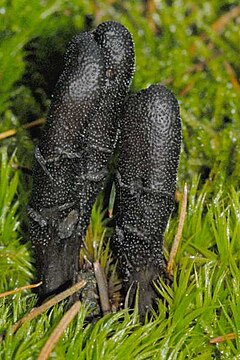Tolypocladium ophioglossoides
Appearance
| Tolypocladium ophioglossoides | |
|---|---|

| |
| Scientific classification | |
| Kingdom: | |
| Division: | |
| Class: | |
| Order: | |
| Family: | |
| Genus: | |
| Species: | T. ophioglossoides
|
| Binomial name | |
| Tolypocladium ophioglossoides | |
| Synonyms[1][2][3] | |
| |
Tolypocladium ophioglossoides, also known by two of its better known synonyms Elaphocordyceps ophioglossoides and Cordyceps ophioglossoides and commonly known as the goldenthread cordyceps,[4] is a species of fungus in the family Ophiocordycipitaceae. It is parasitic on fruit bodies of the truffle-like Elaphomyces. The specific epithet ophioglossoides, derived from Ancient Greek, means "like a snake's tongue".[5]
References
- ^ a b Quandt (2014). "Phylogenetic-based nomenclatural proposals for Ophiocordycipitaceae (Hypocreales) with new combinations in Tolypocladium". IMA Fungus. 5 (1): 121–134.
- ^ "GSD Species Synonymy: Elaphocordyceps ophioglossoides (Ehrh.) G.H. Sung, J.M. Sung & Spatafora". Species Fungorum. CAB International. Retrieved 2014-05-05.
- ^ Sung GH, Hywel-Jones NL, Sung JM, Luangsa-ard JJ, Shrestha B, Spatafora JW (2006). "Phylogenetic classification of Cordyceps and the clavicipitaceous fungi". Studies in Mycology. 57: 5–59. doi:10.3114/sim.2007.57.01. PMC 2104736. PMID 18490993.
- ^ William C. Roody (2003). Mushrooms of West Virginia and the Central Appalachians. University Press of Kentucky. p. 410. ISBN 0-8131-2813-7.
- ^ Pacioni G. (1981). Simon & Schuster's Guide to Mushrooms. Simon and Schuster. p. 349. ISBN 978-0-671-42849-5.
External links
